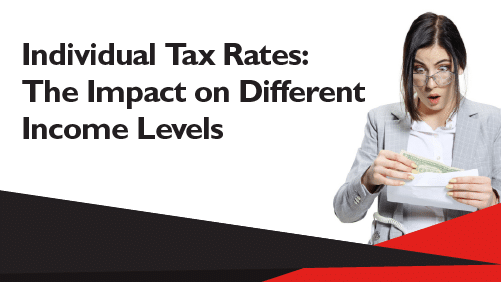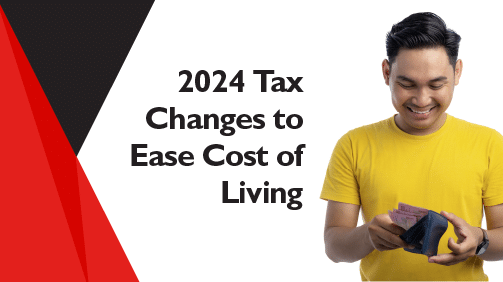Unfortunately, we’ve all been feeling the pinch of the rising cost of living in Australia.
We could use some good news in this regard, right?
Well, here it is! The Australian Taxation Office (ATO) has updated the tax rates and brackets for the 2024-2025 financial year.
With these adjustments, many Australians will see a reduction in their tax rate and an increase in their tax bracket, leaving more money in their pocket to manage everyday expenses and hopefully enjoy a little more financial freedom.
What are these changes, and how will they benefit you?

Overview of Australian Tax Brackets for 2024-2025
Need a reminder of what tax brackets are?
Your taxable income is split into ranges, or “brackets,” each with a different tax rate.
The tax rate increases as your income rises. Lower brackets are taxed at lower rates, while higher brackets are taxed at higher rates.
If your income falls into multiple brackets, don’t worry; you won’t have to pay the highest rate on your entire income.
You’ll just pay the corresponding rate for each portion of your income within those brackets.
The changes to the tax brackets and rates from July 1, 2024, will deliver a tax cut to you and every other Australian taxpayer.
What are the changes?
- 19% tax rate reduces to 16%
- 32.5% tax rate reduces to 30%
- 37% tax threshold increases from $120,000 to $135,000
- 45% tax threshold increases from $180,000 to $190,000
Here are the new tax brackets and their respective rates.
- $0 – $18,200: 0%
- $18,201 – $45,000: 16%
- $45,001 – $135,000: 30%
- $135,001 – $190,000: 37%
- $190,001 and over: 45%
Company Tax Rates for 2024-2025
Do you run a company, corporate unit trust, or public trading trust?
Company tax rates vary between 30% or 25% depending on your company’s type of assessable income.
Your company is eligible for the lower tax rate if it’s a base rate entity from the 2017–18 income year and onwards.
That means its aggregated turnover is below the threshold for that income year, and 80% or less of its assessable income is from passive sources.
The threshold was $25 million in the 2017–18 income year and has increased to $50 million from the 2018–19 income year onwards.
From the 2021–22 income year, companies that are base rate entities apply the 25% company tax rate.
This rate has gradually decreased from 27.5% in the 2017–18 income year.

How the New Tax Brackets Benefit Cost of Living
The government is reducing tax rates and adjusting tax brackets in Australia primarily to alleviate the financial pressure on taxpayers caused by inflation and the rising cost of living.
These changes will especially benefit low-income and middle-income earners, who are most affected by rising costs. How?
Lower tax rates mean individuals retain more of their earnings, which helps to cover essential expenses such as housing, food, and transportation.
And raising the thresholds for higher tax rates means individuals can earn more before being taxed at these higher rates.

Individual Tax Rates: The Impact on Different Income Levels
You’re probably wondering, “How will the 2024 tax changes affect me?”
The ATO’s website has a handy tax calculator that calculates estimated tax cuts, considering the basic tax scales, low-income tax offset (if applicable), and the 2% Medicare levy.
Using this tax calculator, let’s look at some examples of how the changes will affect different salaries.
| Annual Taxable Income | Estimated Tax Liability 2023-2024 | Estimated Tax Liability 2024-2025 | Estimated Tax Cut |
| $30,000 | $1,942 | $1,588 | $354 |
| $75,000 | $16,342 | $14,788 | $1,554 |
| 150,000 | $43,567 | $39,838 | $3,729 |

Can Businesses Take Advantage of These New Tax Brackets?
Impact on Sole Traders
As sole traders report business income as personal income, they can significantly benefit from the updated tax rates and tax brackets in Australia.
The reduction in tax rates for income between $18,201 and $45,000 from 19% to 16% and income between $45,001 and $135,000 from 32.5% to 30% means sole traders will pay less tax on their earnings within these ranges.
With the 37% tax rate threshold increased from $120,000 to $135,000 and the 45% threshold increased from $180,000 to $190,000, sole traders can earn more before reaching these higher tax rates.
With these tax savings, they can
- Grow their business: Purchasing new equipment, expanding operations, and hiring additional staff can contribute to business growth.
- Invest in marketing and development: Marketing efforts can attract more customers, and professional development can enhance the sole trader’s skills and services.
- Build financial security: Additional savings can help build a financial safety net for protection during uncertain times.
Indirect Benefits for Small Businesses
The 2024 tax changes can indirectly benefit small businesses.
- Revenue growth: With people paying less in taxes, their disposable income increases. That means they have more money to spend on goods and services from small businesses.
- Business expansion: With this higher revenue, small businesses may have more capital to reinvest in their operations, including hiring more staff, expanding their product lines, or improving their services.
- Job opportunities: Higher demand can generate job opportunities.
- Economic stimulus: Higher consumer spending can stimulate and stabilise the overall economy, which benefits everyone.
Impact on Companies
The lower company tax rate of 25% for base rate entities means these companies retain more earnings, reducing their overall tax burden.
This lower rate can also make Australian companies more domestically and internationally competitive, helping them attract more business and investment.
Additionally, the increased aggregated turnover threshold of $50 million allows more companies to qualify as base rate entities and benefit from the lower tax rate.
These changes leave companies with more funds for expansion and support overall economic growth in the country.

Strategies to Maximise Tax Efficiency in 2024-2025
Salary Sacrificing and Pre-Tax Deductions
Salary sacrificing, also known as salary packaging, is a strategy where an employee agrees to receive less take-home pay in exchange for benefits provided by their employer.
These benefits are paid for out of pre-tax income, reducing the employee’s taxable income and potentially lowering their overall tax liability.
Salary sacrificing options can include
- Company cars
- Rent-free or reduced-rate accommodation
- Living away from home allowances
- Gym memberships
- Private health insurance
- Reduced interest rate loans
Claiming Work-Related Expenses
Claiming work-related expenses reduces your taxable income, lowering your overall tax liability and letting you keep more of your hard-earned money.
You can claim expenses related to
- Using your car for work (excluding commuting), travel between work sites, and business-related travel
- Uniforms, protective clothing, and occupation-specific clothing
- Running a home office, including office supplies and a portion of internet and phone bills
- Purchasing and maintaining tools and equipment required for your job
- Courses and training related to your job
Businesses can claim expenses related to
- Office supplies and equipment
- Rent and utilities
- Accountants, lawyers, and other professional services
- Marketing and advertising
- Employee wages and superannuation contributions
How to claim:
- Keep receipts, invoices, and records of all expenses
- Log work-related usage of vehicles and home office utilities
- Fill out the relevant sections on your tax return to claim deductions
- Employ the services of a tax professional to maximise your deductions

2024 Tax Changes to Ease Cost of Living
The ATO is throwing us a lifeline with these new tax rates and tax brackets in Australia.
Will you take full advantage of them?
As tax professionals here at Pherrus, we can help.
We’ll work hard to strategise ways to further reduce your tax liability and find all the credits and deductions you’re entitled to.
For stress-free, smart tax management, contact us today by filling out this online form or calling +61 (02) 9099 9109 to book an appointment at our Bella Vista office in Sydney, NSW.

FAQs
How Do the New Tax Brackets Compare to the Previous Year?
From July 1, 2024, the 19% tax rate will reduce to 16%, and the 32.5% rate to 30%.
The 37% tax threshold will increase from $120,000 to $135,000, and the 45% threshold from $180,000 to $190,000.
Who Benefits the Most From the Updated Tax Brackets?
The reductions in tax rates and higher thresholds mean low and middle-income earners, in particular, will see significant tax savings, increasing their disposable income and easing their financial burden.
Can Businesses Take Advantage of These New Tax Brackets?
As sole traders report business income as personal income, they can take advantage of the new personal tax rates and brackets.
While businesses cannot take advantage of these changes, they can benefit indirectly.
With people paying less in taxes, their disposable income increases, and they’re more likely to spend money on goods and services.





